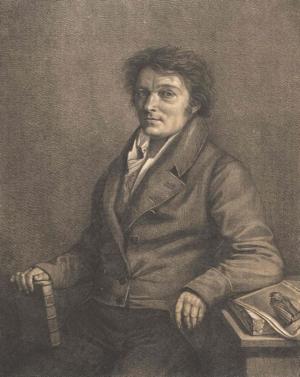 SKC Films Library |
| SKC Films Library >> Fine Arts >> Lithography |
| Aloys Senefelder [ah' lois zey' nuh fel der] the inventor of lithography
Aloys Senefelder was born in Prague, Bohemia (now in the Czech Republic), on November 6, 1771, the son of an actor. He studied at Munich, where his diligence earned him a scholarship to study law at Ingolstadt. The death of his father in 1791 forced him to leave school in order to help support his mother and seven siblings. He took up the writing of plays but was unable to have them published because he did not have enough money to pay for their engraving. He decided, therefore, to do the engraving himself, and bought the copper plates on which to do so. The results were not encouraging, but Senefelder refused to give up. One day in 1796, Senefelder happened to use a grease pencil to note down a laundry list on a slab of limestone. At first he thought that if he etched away the surface of the surrounding stone the markings would stand out in relief. Senefelder spent two years testing out his idea, using metal surfaces as well as various types of stone. He eventually came up with a flat surface method of printing -- what we now know as lithography. The method is based on the principle that grease and water are mutually repellent. The design to be reproduced is drawn directly on the stone with a greasy ink or a grease crayon. The stone is then wetted. When oil printing ink is applied, it leaves the wet surfaces of the stone clean but adheres to the grease in the design drawing. The lithograph can now be made by a direct impression on a sheet of paper pressed on top of the stone. Senefelder called this process "chemical printing." the principle of lithographic
printing The number of impressions that can be made from one plate is virtually unlimited, and each impression is remarkably sensitive in reproducing the original in all its details. Whats more, a design transferred from the stone to the paper can then be transferred in turn on to a clean stone, and the same thing done as many times as the designer likes. In this way, several copies of a design can be printed off simultaneously on one large sheet of paper. Senefelder explained the lithographic process in A Complete Course of Lithography, published in 1818. He was awarded a gold medal by the Society of Encouragement of England, the highest medal of the Polytechnische Verein fur Baiern, the gold honorary medal of the Order for Civilverdienst of the Bavarian Crown, and various other prizes for his development of lithography. frontispiece of 'A Complete Course
of Lithography' The French painters Théodore Géricault and Eugène Delacroix first saw the advantages of lithography to convey their artistic intentions in the 1820's. Goya, in his old age, took up lithography and produced a well-known series of bull-fighting subjects. The printmaker, caricaturist, and painter Honoré Daumier did much of his most important work in the form of lithographs, using an adaptation of the method in which the picture was drawn in greasy ink on paper before being transferred to the stone -- a method that greatly increased subtleties of textures. Color lithography was developed in the middle of the 19th century, using a whole series of stones because one stone had to be used for each individual color. The most successful and best-known results of the technique were the posters of Henri de Toulouse-Lautrec. Lithography remains an important medium for artistic impression. Among the modern artists who have used it are Picasso and Henry Moore. Aloys Senefelder died in Munich on February 26, 1834. PRINT SOURCE WEB SOURCE SEE ALSO |
| SKC Films Library >> Fine Arts >> Lithography This page was last updated on 11/06/2017. |




